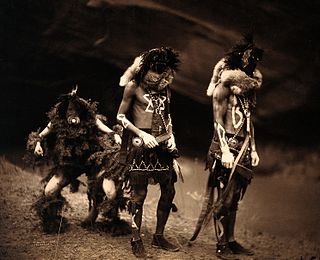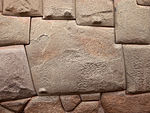
The Sioux or Oceti Sakowin are groups of Native American tribes and First Nations people from the Great Plains of North America. The Sioux have two major linguistic divisions: the Dakota and Lakota peoples. Collectively, they are the Očhéthi Šakówiŋ, or "Seven Council Fires". The term "Sioux", an exonym from a French transcription ("Nadouessioux") of the Ojibwe term "Nadowessi", can refer to any ethnic group within the Great Sioux Nation or to any of the nation's many language dialects.

A sauna is a room or building designed as a place to experience dry or wet heat sessions, or an establishment with one or more of these facilities. The steam and high heat make the bathers perspire. A thermometer in a sauna is typically used to measure temperature; a hygrometer can be used to measure levels of humidity or steam. Infrared therapy is often referred to as a type of sauna, but according to the Finnish sauna organizations, infrared is not a sauna.

A temazcal is a type of sweat lodge, which originated with pre-Hispanic indigenous peoples in Mesoamerica. The term temazcal comes from the Nahuatl language, either from the words teme and calli (house), or from the word temāzcalli.

The American Indian Movement (AIM) is an American Indian grassroots movement which was founded in Minneapolis, Minnesota in July 1968, initially centered in urban areas in order to address systemic issues of poverty, discrimination, and police brutality against American Indians. AIM soon widened its focus from urban issues to many Indigenous Tribal issues that American Indian groups have faced due to settler colonialism in the Americas. These issues have included treaty rights, high rates of unemployment, the lack of American Indian subjects in education, and the preservation of Indigenous cultures.
A vision quest is a rite of passage in some Native American cultures. It is usually only undertaken by young males entering adulthood. Individual Indigenous cultures have their own names for their rites of passage. "Vision quest" is an English-language umbrella term, and may not always be accurate or used by the cultures in question.

The Sun Dance is a ceremony practiced by some Native Americans in the United States and Indigenous peoples in Canada, primarily those of the Plains cultures. It usually involves the community gathering together to pray for healing. Individuals make personal sacrifices on behalf of the community.
Neoshamanism refers to new forms of shamanism. It usually means shamanism practiced by Western people as a type of New Age spirituality, without a connection to traditional shamanic societies. It is sometimes also used for modern shamanic rituals and practices which, although they have some connection to the traditional societies in which they originated, have been adapted somehow to modern circumstances. This can include "shamanic" rituals performed as an exhibition, either on stage or for shamanic tourism, as well as modern derivations of traditional systems that incorporate new technology and worldviews.
The inípi ceremony, a type of sweat lodge, is a purification ceremony of the Lakota people. It is one of the Seven Sacred Ceremonies of the Lakota people, which has been passed down through the generations of Lakota.
Chanunpa is the Lakota language name for the sacred, ceremonial pipe and the ceremony in which it is used. The pipe ceremony is one of the Seven Sacred Rites of the Lakota people. Lakota tradition has it that White Buffalo Calf Woman brought the chanunpa to the people, as one of the Seven Sacred Rites, to serve as a sacred bridge between this world and Wakan Tanka, the "Great Mystery".
Plastic shamans, or plastic medicine people, is a pejorative colloquialism applied to individuals who are attempting to pass themselves off as shamans, holy people, or other traditional spiritual leaders, but who have no genuine connection to the traditions or cultures they claim to represent. In some cases, the "plastic shaman" may have some genuine cultural connection, but is seen to be exploiting that knowledge for ego, power, or money.
Vern Harper Vernon Harper born on June 17, 1936 in Regent Park Toronto, Ontario – May 12, 2018) was a Canadian First Nations Cree Elder, medicine man, and Aboriginal rights activist.
Alex White Plume is the former vice president and president of the Oglala Sioux Tribe of the Pine Ridge Reservation, located on South Dakota of the United States. He served as president from June 30, 2006 to November 2006 after Cecilia Fire Thunder was impeached.

Indigenous intellectual property is a term used in national and international forums to describe intellectual property that is "collectively owned" by various Indigenous peoples, and by extension, their legal rights to protect specific such property. This property includes cultural knowledge of their groups and many aspects of their cultural heritage and knowledge, including that held in oral history. In Australia, the term Indigenous cultural and intellectual property, abbreviated as ICIP, is commonly used.

Native American religions are the spiritual practices of the Native Americans in the United States. Ceremonial ways can vary widely and are based on the differing histories and beliefs of individual nations, tribes and bands. Early European explorers describe individual Native American tribes and even small bands as each having their own religious practices. Theology may be monotheistic, polytheistic, henotheistic, animistic, shamanistic, pantheistic or any combination thereof, among others. Traditional beliefs are usually passed down in the forms of oral histories, stories, allegories, and principles.

Archie Fire Lame Deer or Tȟáȟča Hušté (1935–2001) was a US Army veteran, a Wicasa Wakan or Medicine man and a lecturer on Lakota people, traditions and religion. He grew up on the Rosebud Indian Reservation served in the US Army during the Korean war, was a Hollywood stuntman and translator. With Richard Erdoes he wrote Gift of Power: the life and teachings of a Lakota medicine man. He is the son of Lakota medicine man John Fire Lame Deer and the subject of the classic book, "Lame Deer Seeker of Visions” with Richard Erdoes.

James Arthur Ray is an American self-help businessman, motivational speaker, author and convicted criminal who was found guilty in 2011 of causing three deaths through negligent homicide.
The red road is a modern English-language concept of the right path of life, as inspired by some of the beliefs found in a variety of Native American spiritual teachings. The term is used primarily in the Pan-Indian and New Age communities, and rarely among traditional Indigenous people, who have terms in their own languages for their spiritual ways. Native Americans' spiritual teachings are diverse. With over 500 federally-recognized tribes in just the US, while some regional practices and beliefs might be similar, the cultures are highly individualized. Individual ceremonies and particular beliefs tend to be unique to the people of these diverse bands, tribes and nations.

Two-spirit is a contemporary pan-Indian umbrella term used by some Indigenous North Americans to describe Native people who fulfill a traditional third-gender social role in their communities.

The Wolf Award is an accolade conferred by a non-profit organization known as The Wolf Project to individuals, organizations, and communities in recognition of their efforts to reduce racial intolerance and to improve peace and understanding. The Wolf Award, which has also come to be known as The International Wolf Award, consists of a certificate of appreciation and a sculpture of a howling wolf, presented in ceremonial fashion to the recipient.

Arvol Looking Horse is a Lakota Native American spiritual leader. He is the 19th keeper of the Sacred White Buffalo Calf Pipe and Bundle.














